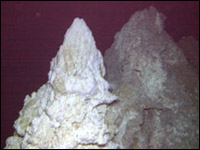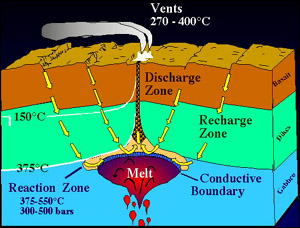"When I first saw them ..."
Cruise-changing serendipity struck for expedition members early on the morning of Monday, Dec. 4, in the cramped confines of the Argo-II control van on a deck of the R/V Atlantis.
After dark on Sunday, the unmanned towed submersible had begun reconnoitering another part of the massif, where members of the science team's first watch were impressed by some showoff fish that seemed to mug for Argo's cameras.
Shortly after midnight, after second shift leader Barbara John's watch began, some "amazing white structures" started looming on the video monitor screens , John recalled.
"When I first saw them I thought they were corals," added Gretchen Frueh-Green, an expedition member from ETH in Zurich, Switzerland, who studies interactions between rocks and fluids.
"Then I looked closer and realized they weren't living organisms. When we closed in more, I realized they were hydrothermal structures. Then I went and got Debbie."

Fig. 1. Cone-shaped pinnacles rise from a central edifice in the Lost City hydrothermal field. Actively venting, white colored chimneys stand in sharp contrast to beige colored edifices that are now extinct. This image shows the top 20 feet of a structure that stands 160 feet above the seafloor. Photo courtesy National Science Foundation news release, http://www.nsf.gov/od/lpa/news/press/00/pr0093.htm.
Deborah Kelley has worked for years on mid-ocean ridge fluid-rock interactions and associated hydrothermal vents - both induced when seawater percolating kilometers beneath the ocean floor is heated by magma or hot rocks beneath the seafloor.
As other scientists were called in too, in-and-out van spectator traffic increased noticeably as Karson and Kelley started calling out odd features for others to tap into computer data bases.

Fig. 2. Generalized diagram of hydrothermal circulation with formation of chimneys at midocean ridges. Image provided by Deborah Kelley, University of Washington.
It soon became apparent that Argo's cameras had discovered a cluster of hydrothermal vents, though it wasn't immediately clear if they were currently active. The scientists knew these were vents because of the fanciful structures they saw there. Some had the inverted cone shapes of stalagmites in caverns. Others had the more needle-like look of cathedral spires. Some deposits, like those Frueh-Green spied initially, were as delicately crystalline as frost on a windowpane.
Today's pages:
"When I first saw them ..." | The towers | "... how little we know" | Life between a rock and a hot place | Plans for the lab back home

|







